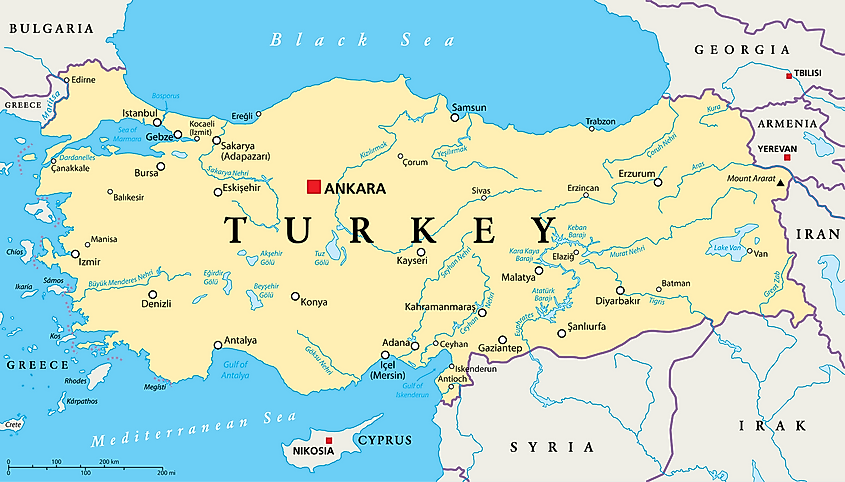Is Turkey In Europe Or Asia?

- Turkey has territory in both Europe and Asia, though the vast majority of its territory is considered part of Asia.
- Turkish territory once stretched deep into Europe, all the way to the outskirts of Vienna, now the capital of Austria.
- The Turks originally came from East Asia.
- Turkey's biggest city, Istanbul, is the most populous city in Europe.
- Turkey had an influence on European demographics. Adversely, Turkey has also adopted many facets of European culture.
The vast majority of Turkey’s territory is in Asia, but a small part of it is in Europe. Most of Turkey consist of the region known as Anatolia, or Asia Minor. A small part of Turkey, however, is situated in a region known as Thrace, which is the southeast corner of the Balkan Peninsula. This is where you will find part of Turkey’s largest city, Istanbul. Interestingly, however, the origins of the Turkish people are not in their present homeland, but much farther away in East Asia. Nevertheless, Turkey has long played a part in European history. In fact, Turkish territory once stretched deep into Europe during the height of the Ottoman Empire, all the way to the outskirts of what is now Austria’s capital, Vienna. Although Turkey now occupies just a sliver of Europe today, Turkish influence is still visible on the continent. At the same time, Turkey has also adopted many cultural elements of Europe, and has aligned itself with the West politically and economically.
The Territory Of Turkey

As previously mentioned, the vast majority of Turkey’s territory is in the region of Anatolia, which is sometimes called Asia Minor, and is part of the Asian continent. Most of Turkey’s population of roughly 85 million lives in Anatolia. The Anatolian part of Turkey is bordered to the northeast by Georgia, Armenia, and Azerbaijan, to the east by Iran, to the south by Iraq, Syria, and the Mediterranean Sea, to the north by the Black Sea, and to the west by the Aegean Sea and Greece. Turkey’s capital, Ankara, which is a city of more than 3.5 million people, is located in the west-central part of Anatolia. Almost all of Turkey’s major cities are also located in Anatolia. In fact, all of Turkey’s cities with populations of more than 1 million people are located in Anatolia, except for part of Turkey’s largest city, Istanbul.

Part of Istanbul is located in Turkey’s small foothold in Europe, in the southeastern part of the region known as Thrace, which spans the European part of Turkey, northeastern Greece, and southeastern Bulgaria. Turkey’s part of Thrace is bordered to the north by Bulgaria, to the northeast by the Black Sea, to the south by the Sea of Marmara, to the west by Greece, and to the east by the highly strategic Bosporus Strait, which separates the European part of Turkey from Anatolia. Interestingly, although part of Istanbul lies in Anatolia, and is therefore part of Asia, the city is actually considered the most populous city in Europe, with a population of more than 15 million.
The Asian Origins Of The Turks

Although the Republic of Turkey is the current homeland of the Turks, it was not always so. In fact, the origins of the Turkish people are nowhere close to Europe, but much farther to the east in East Asia, or more specifically, the Altai Mountains of what is now western Mongolia. They began migrating west in the second half of the first millennium CE. By the 11th century, the Turks had reached the edges of Anatolia, which was then mostly populated by the Greeks. In 1037, Turkic tribes formed the Seljuk Empire, which would go on to conquer Anatolia. Large numbers of Turks then began streaming into Anatolia. After a long process of so-called Turkification, most of Anatolia’s population adopted the Turkish culture, language, and Islamic religion. Eventually, what is now Turkey became the largest bastion of Turkic-speaking people in the world.
Turkey And European History

Although Turkey has just a small part of European territory today, it once had control over a vast part of the continent, thus making Turkish history part of European history. This was during the time of the Ottoman Empire. At its height, the Turkish Ottoman Empire had conquered the entire Balkan Peninsula. In 1683, the Turks reached the outskirts of what is today the Austrian capital, Vienna, but were ultimately defeated, marking the beginning of the Ottoman Empire’s decline. By the early 20th century, the Ottoman Empire lost nearly all its territory in Europe, except for the area in the region of Thrace that remains part of Turkey to this day. Nevertheless, the Turks had a profound effect on the demographics of today’s Europe.
Turkey’s European Ties Remain

Although Turkey no longer controls large parts of Europe, it left a lasting legacy on the continent. For example, the Ottoman Empire spread the Islamic faith to large portions of the European population. As a result, some people in Europe, most notably in Albania and a part of Bosnia and Herzegovina’s population, still profess Islam today.
At the same time, European culture has found its way into Turkey, especially over the past hundred years. After World War I, which marked the fall of the Ottoman Empire, the new leader of Turkey, Mustafa Kemal Ataturk, decided to westernize the country. The old Islamic Caliphate of the Ottoman Empire was dissolved, and a modern, secular republic created. Turkey even adopted a Latin script for the Turkish language, replacing the language’s Arabic script. For the next 100 years, Turkey would align itself with the West politically and economically.











